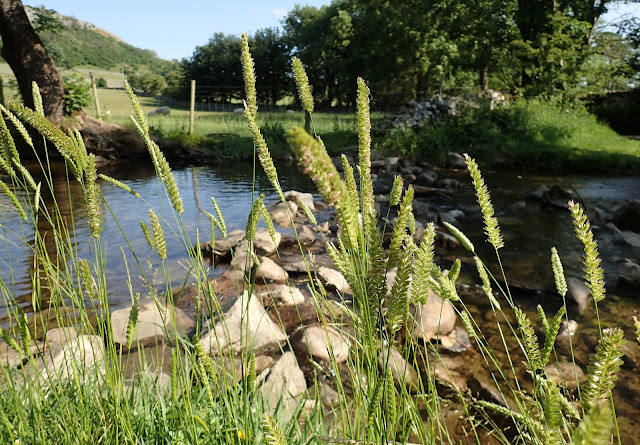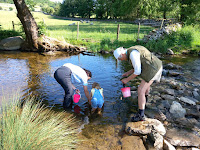Two Day - NON residential course on Gasses, Sedges and Rushes at Blencathra 24-25 June 2023I and three of the students are fortunate to be able to stay at the centre - they are catering for a Carlisle Rugby club Dads and Lads weekend, and a girls school geography course. So I arrive the night before and set up the lab. The other students have to find their own accommodation, or live nearby.
At 9 o'clock the students come in. As a well proved icebreaker, I set them to work "interviewing " the person sat next to them, ready for them to introduce their partner to the rest of the group.
Who comes on such courses? people often ask me.
Well, this group includes one seasoned botanist (here on holiday), one retired person, a beginner who is here to accompany their partner, another person who is interested as a hobby, and the rest are here from work - i.e. people working for organisations that do environmental work, from carrying out bat surveys to advising farmers and landowners and planners about what they can do with their land, or working for Natural England. So an improved ability to recognise different species of plants is useful for them.
After a morning session on Grass parts we collect our rucksacks and walk up the very steep fellside path above the centre for all of about 1/8 of a mile to the old quarry area. The bracken beside the path is significantly taller than when a came last year, two weeks earlier. The path is yellow with dead grass. On the sides of our little quarry heather is still growing.

Many of the grasses are amazingly dead. Look at the grass in the right of the picture.
Sorry I can't prevent my self from saying this - over and over again - nearly every third sentence. Cumbria has been having even more of a drought than Yorkshire. It started raining a week ago - so some plants have perked up but many others have died in the six weeks of no rain before that. The soil at the quarry is very shallow.
I set the students the task of finding 10 grasses before lunch (including rushes and sedges) - a bit optimistic perhaps - I see we only found 9 species of grass here last year.
Nardus stricta (Mat grass) and Aira praecox (Early Hair grass) are both abundant.
But it makes us all look carefully. Over lunch we enjoy the view of the several valleys below. Robert finds a nice plant of Parsley Fern which has both vegetative and reproductive fronds.

We return to the lab, collecting a few more on the path on the way down, and sort the specimens.
I give them my "Introduction to Sedges" talk too - ready for the next day - we go overtime by 17 minutes, but no-one seems to mind. It will be good to be able to go out the next day first thing, rather than stay inside for the sedges talk first.
They they go off to their respective hotels or to their homes and six of us will later sit down at the Field Centre dining room.
In the evening I tidy my section of the lab - how have all the students left their parts tidy, and mine is still a pile of books and grasses and papers?
I sit own at my laptop to check emails. And to check the News website: What is this a student was saying about Putin and the revolt by the Wagner group mercenaries led by their Wagner leader Yevgeny Prigozhin?
History in the making. It is Sat 24 June 2023.
The meal to night is Mushroom stroganoff with pasta and there was a different selection of salad - rocket and coleslaw. Desert was a cakey chocolatey/fruit slab with butterscotch sauce. I pile on lots of extra sauce.
I popped up to the bar. - On many occasions to Blencathra I have missed this, only discovering its where-abouts last year. The lady at the counter turns out to be the cook (or assistant cook) working up here tonight on her day off. - It is only open because of the Carlisle Rugby group she says.
I say how much I am enjoying the salads extra to the main meal. (I could pile salad on and pretend the main meal wasn't too fattening) She says - interestingly - that this is done specially because schools have to do this now - had to have salad to go with their meals. (I wondered if this happens at all schools? My dismal memories from teaching in schools were of most children always selecting gravy and chips)
The rugby club cheerfully invite me to join them for their quiz, but I say I needed to go for a walk.
Which I do. I met one of my group who had done a long walk. But I just walk along the track above the centre, horizontally round to the valley which looks up towards Skiddaw. Eventually I got away from the noise of the A66.
I noted a few lichens: Baemyces rufus, various Cladonias. The vegetation is so dry, and dying back leaving more space for lichens.
Back in my bedroom I roll down the blinds on the two roof windows so that the room will not get light at 4.30am. I try to sleep - hoping that we will easily find a parking space close to our Field site tomorrow.
-------------------------------------------------------
I remember the pictures I took early this morning before breakfast and straight after the heavy rain the previous evening
For example here are some big blobs of a bright yellow lichen growin on the bank retaining wall above the cottages. I think it is Caloplaca flavovirescens. It is growing on hard acid rock, but maybe there is some nutrient input from the ledges and the soil on the bank above.

 |
| Caloplaca flavoviresens? - not at its best when drowned in rainwater. |
 |
| A sycamore forest in the making - even though it is growing amongst Beech Mast |
 |
A sycamore forest in the making - even though it is growing amongst Beech Mast
|
 |
| Carex |
See our trip the next day on Sunday 25 June























































